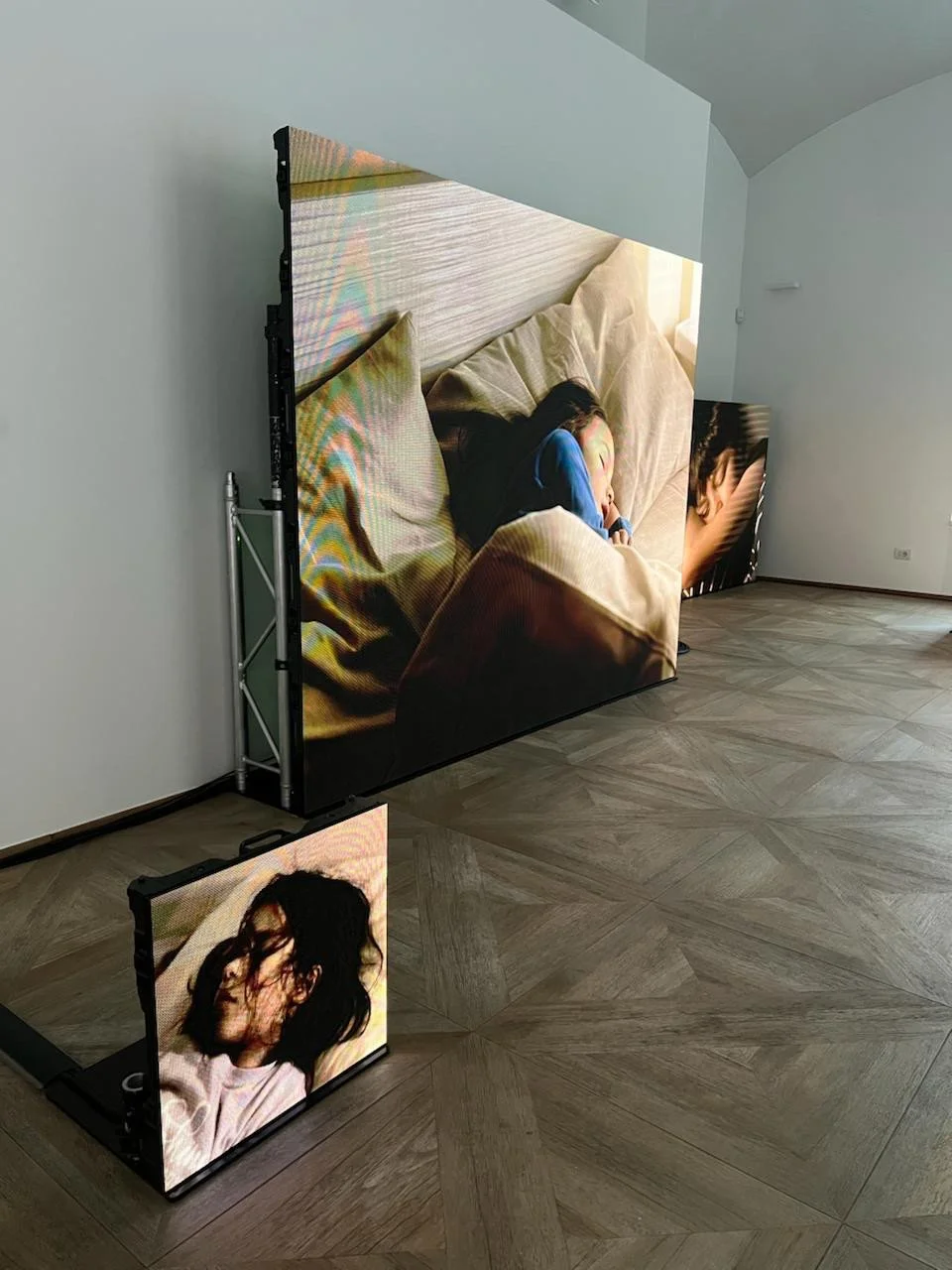Lick the walls to understand echoes
‘Lick the walls to understand echoes’ sets its roots inside HOLON Berlin with a sense of intent that feels both immediate and contemplative. The title sounds playful, yet it points toward a method. A way of reading sound through contact. A way of registering its residue on the body. HOLON presents a platform where artists can move freely through ideas that carry weight in our current moment, and this exhibition continues that commitment with clarity.
The project joins the work of Abigail Toll and Anton Filatov, two voices with different fluencies who converge around one shared question. How can sound form an environment that guides perception beyond the surface of hearing. Abigail Toll approaches this through psychoacoustic composition shaped around the conceptual threads of her new album Idol. Anton Filatov builds visual and spatial responses that react to her score with precision. Their collaboration forms a room where colour, motion, and frequency react to one another with a steady pulse.
The installation draws initial energy from a site far from Berlin. In the early stages of Abigail Toll’s writing process, she found herself inside Malta’s Ħal Saflieni Hypogeum temple, a space known for its unusual acoustic behaviour. The chamber produces resonance that carries a quiet force. Notes cling to stone. Breath thickens in the air. She kept that encounter close and treated it as a reference point for this exhibition. Rather than recreate the temple, she traced how its atmosphere shaped her thoughts and folded that influence into her sound design.
Anton Filatov extends that direction through his interactive scenography. Light moves with patience. Surfaces respond to vibration. The room takes cues from ancient architecture without falling into imitation. Instead, it suggests an attitude. A way of approaching ritual, memory, and the symbolic frameworks that guided early cultures. Nothing nostalgic, nothing romantic. Instead, a suggestion that human attention once moved differently and that this shift matters now, in a world that favours speed and distraction.
HOLON frames the exhibition inside its broader research mission. The program grew from MONOMANGO with the goal of creating tools for collective thought that can link physical and virtual arenas. ‘Lick the walls to understand echoes’ expands that intention. Visitors encounter a place where sensory engagement becomes a method for learning. Sound, space, and interaction act as points of access into ideas that often remain theoretical. Here they come through touch, vibration, and colour.
The exhibition arrives within a larger cultural landscape charged with technological acceleration. Ritual feels fragmented. Symbolic language drifts toward convenience. The installation does not replace these gaps with new icons, nor does it critique them through distance. Instead, it invites viewers to pay attention to the subtle ways sound can organise meaning. A low frequency can anchor the body. A slight shimmer of light can shift mental rhythm. A pulse can guide observation. These small gestures open routes toward understanding that depend on presence rather than spectacle.
The title functions as a proposition. It suggests that knowledge forms through contact. That each surface retains memory. That echoes carry stories of their own. The exhibition respects that idea through an arrangement where every element participates in a shared field. Nothing loud for its own sake. Nothing ornamental. Every choice carries purpose.
HOLON continues to grow as a site where research, play, and artistic experimentation can meet with sincerity. ‘Lick the walls to understand echoes’ stands as another chapter in that trajectory. It encourages visitors to trust their sensory instincts and to move through the room with patience. Sound reveals itself through slow attention. Space responds to that awareness. The exhibition offers a framework where listening becomes a way to think, and where echoes speak in more ways than one.
Abigail Toll
Abigail Toll creates sonic frameworks that reveal how sound interacts with architecture and consciousness. Her compositions carry a steady focus on resonance and the subtle shifts it produces when it moves through a room. Critical attention around her debut album highlighted the care and complexity embedded in her approach, and her forthcoming release extends this trajectory. With presentations across a wide range of cultural venues, she has built a practice that treats listening as an active form of study and positions sound as a force that shapes inner and outer environments.
Anton Filatov
Anton Filatov builds environments where sound, light, and spatial structure operate as one system. His work sits at the intersection of digital craft and physical presence, forming installations that respond with precision to each shift in tone or movement. Festivals and institutions such as Lunchmeat, Dekmantel, CTM, and Somerset House have presented his projects, confirming his position as a key voice in contemporary audiovisual practice. He also collaborates with international musicians and performers, expanding his reach and refining his sense of atmosphere and immersive design.
What to read next
































